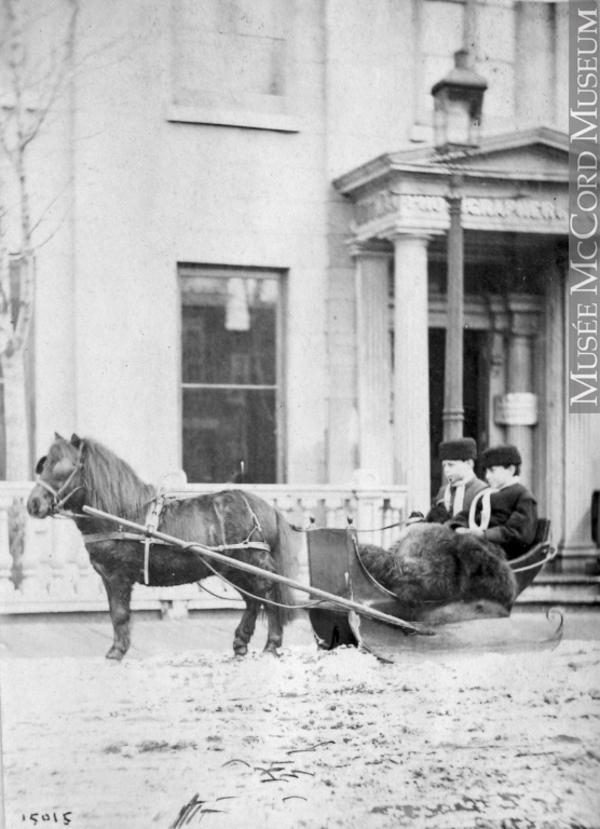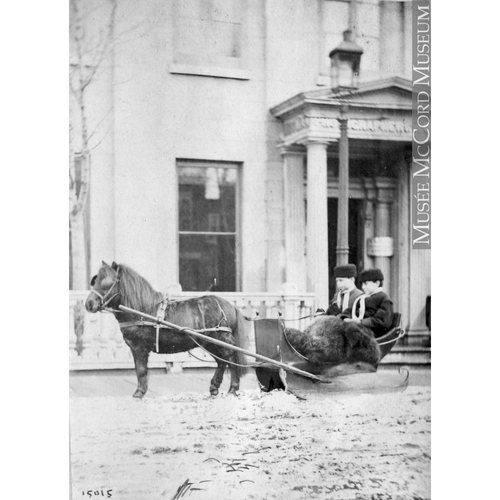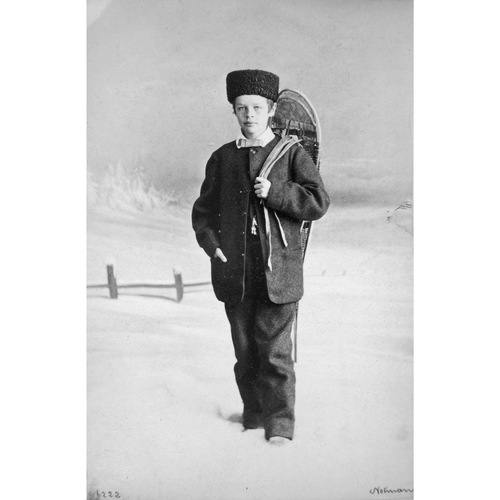
Source: Link
GREENSHIELDS, EDWARD BLACK, businessman and art critic; b. 12 July 1850 in Montreal, eldest son of John Greenshields, a prominent dry goods merchant, and Elizabeth Black, daughter of the Reverend Edward Black*; m. 19 Oct. 1876, at Quebec, Eliza Eleanor Brodie Cook, daughter of the Reverend John Cook*, and they had two children; d. 22 April 1917 in Montreal.
Edward Black Greenshields was educated at the High School of Montreal and at McGill College, where in 1869 he received a ba with first-class honours in mental and moral philosophy and won the Prince of Wales Medal. While a student, he had joined the 3rd Battalion Volunteer Militia Rifles and had seen active service during the Fenian raids of 1866. In 1868 he attended militia school and he became a second lieutenant the following year. He left the militia with the rank of captain on 12 Feb. 1875.
Greenshields had begun his apprenticeship in the family wholesale dry goods firm, S. Greenshields, Son and Company, in 1869. Initially known as Samuel Greenshields and Son, the business had been established by his grandfather Samuel, a merchant from Glasgow, and his father, John, in 1833. Edward Black became a partner in 1876, head of the firm in 1888, and president of Greenshields Limited in 1903. He presided over the expansion of the business across Canada. By 1907 the company was the country’s largest supplier of both imported and domestic dry goods. It handled cottons, woollens, carpets, household furnishings, dress goods, and notions such as gloves, hosiery, and laces. In addition, it was the exclusive agent in Canada for several prestigious British and European manufacturers.
A prominent businessman, Greenshields was active in the defence and promotion of his industry. Acting for textile-mill owners and shirt manufacturers, he lobbied the federal government on tariff policy and he served as president of the Montreal Wholesale Dry Goods Association in 1896. His stature within the Montreal business community is confirmed by his directorships in the Bank of Montreal, the Royal Trust Company, the Standard Life Assurance Company, the Ocean Accident Corporation, and the Grand Trunk Pacific Railway. As president of the Montreal Board of Trade in 1892, he advocated honest government, the elimination of canal tolls, and a more equitable distribution of money to creditors under the Insolvent Act. He oversaw the completion of a new building for the board and the celebration of its 50th anniversary.
By 1900 he was devoting less time to business and more to travel, leisure, and cultural and scholarly activities. He made numerous trips to various parts of Europe and the United States. He usually spent the winter months in Montreal and part of the summer in Cacouna or at Lake Memphrémagog. He enjoyed biking, motoring, sailing, golfing, and popular entertainments such as Buffalo Bill’s Wild West Show, minstrel shows, and musicals.
Greenshields’s interest in cultural activities is reflected in his attendance at numerous art shows, as well as in his visits to art galleries and museums. Like several of his Montreal contemporaries, such as Sir William Van Horne and Lord Strathcona [Smith], he was an avid art collector. Although the prominent businessmen who dominated the Art Association of Montreal (and art collecting in general in Montreal) had individual tastes, they placed emphasis on acquiring traditional works of the French and English academic schools, the Barbizon School, and the Hague School and demonstrated much less interest in the Impressionists. Greenshields was the foremost proponent of the Hague School in Canada. He promulgated his views through his own collecting, as a member of the exhibition committee of the Art Association (where he influenced the selection of paintings), and as an art scholar. He wrote two of the first major Canadian works of criticism on European art, The subjective view of landscape painting and Landscape painting and modern Dutch artists. Both books were devoted to promoting the Hague School and to dismissing Impressionism as having little lasting artistic value.
Greenshields believed art to be the personal, mystical effect produced on the artist by nature. In his rather stolid, mainly unpublished, poetry this conception of art and nature is also an important theme. Therefore the Hague School’s romantic, subjective vision of nature, expressed through solid, usually sombre landscapes, struck an intellectual chord with Greenshields. The tranquil images of the countryside, devoid of obvious social tensions or conflicts, were also attractive to his aspiration, as a businessman, for social stability. Overall, his conceptualization of art was traditional and safe; his individual preferences were also financially sound investments. For him, there were no major contradictions between his views on art and his social status.
Like many of his fellow businessmen, Greenshields promoted education. A prominent member of McGill University’s board of governors from 1887 to 1917, he was its honorary treasurer from 1903 to 1910, during a period of financial crisis brought on by fires in two buildings. He was also a member of various committees of the board, and received an honorary lld in 1910. As a result of his interests in art and literature Greenshields was more active in the intellectual life of the university than most of his colleagues on the board of governors. For example, in 1908 he published an article in the University Magazine on Canadian poet Charles Heavysege*. His cogent analysis of Heavysege as a poet of great insight and skill hampered by an inconsistent technique compares favourably with other critiques of the poet.
A prominent member of Montreal’s Scottish community, Greenshields belonged to St Paul’s Presbyterian Church and to the St Andrew’s Society. The amount of time he devoted to the society appears to have been limited, however. Although elected vice-president in 1894 and president for 1895, he declined to act, explaining in his diary that he had no time for either job. He died in Montreal in 1917 following a four-month-long, heart-related illness.
A speech given by Edward Black Greenshields as president of the Montreal Board of Trade on the occasion of its 50th anniversary was printed with its Report for 1892. His other publications are The subjective view of landscape painting, with special reference to J. H. Weissenbruch and illustrations from works of his in Canada (Montreal, 1904); Landscape painting and modern Dutch artists (Toronto, 1906); “A forgotten poet,” University Magazine (Montreal), 7 (1908): 343–59; and Poems (Montreal, n.d.).
ANQ-M, CE1-130, 25 août 1850. ANQ-Q, CE1-66, 19 oct. 1876. McGill Univ. Arch. (Montreal), RG 4 (secretariat of the Royal Institution for the Advancement of Learning and the board of governors), c.7–9; RG 8 (secretariat of senate), c.8. McCord Museum of Canadian Hist. (Montreal), Greenshields family papers; Victoria Rifles of Canada. Gazette (Montreal), 23 April 1917. Art Assoc. of Montreal, 17th loan exhibition on the occasion of the opening of the new gallery, 29 November 1893 (Montreal, 1893). The book of Montreal, a souvenir of Canada’s commercial metropolis, ed. E. J. Chambers (Montreal, 1903). Janet Brooke, Discerning tastes: Montreal collectors, 1880–1920 (exhibition catalogue, Montreal Museum of Fine Arts, 1989). M. H. Hurdalek, The Hague School: collecting in Canada at the turn of the century, May 7–June 26, 1983 (exhibition catalogue, Art Gallery of Ontario, Toronto, 1984). McGill Univ., Annual calendar (Montreal), 1870/71. Alfred Sandham and William Norman, McGill College and its medals (Montreal, 1872). F. W. Terrill, A chronology of Montreal and of Canada from A.D. 1752 to A.D. 1893 . . . (Montreal, 1893). Who’s who and why, 1915/16.
Cite This Article
Gordon Burr, “GREENSHIELDS, EDWARD BLACK,” in Dictionary of Canadian Biography, vol. 14, University of Toronto/Université Laval, 2003–, accessed January 19, 2026, https://www.biographi.ca/en/bio/greenshields_edward_black_14E.html.
The citation above shows the format for footnotes and endnotes according to the Chicago manual of style (16th edition). Information to be used in other citation formats:
| Permalink: | https://www.biographi.ca/en/bio/greenshields_edward_black_14E.html |
| Author of Article: | Gordon Burr |
| Title of Article: | GREENSHIELDS, EDWARD BLACK |
| Publication Name: | Dictionary of Canadian Biography, vol. 14 |
| Publisher: | University of Toronto/Université Laval |
| Year of publication: | 1998 |
| Year of revision: | 1998 |
| Access Date: | January 19, 2026 |




